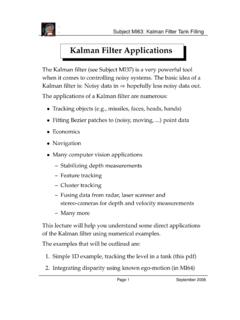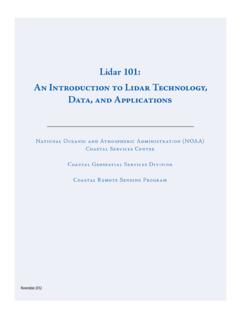Transcription of Chapter 4 Fundamentals of Laser-Material Interaction and ...
1 Chapter 4 Fundamentals of Laser-Material Interactionand Application to Multiscale SurfaceModificationMatthew S. Brown and Craig B. ArnoldAbstractLasers provide the ability to accurately deliver large amounts of energyinto confined regions of a material in order to achieve a desired response. Foropaque materials, this energy is absorbed near the surface, modifying surface chem-istry, crystal structure, and/or multiscale morphology without altering the bulk. Thischapter covers a brief introduction to the fundamental principles governing laserpropagation and absorption as well as the resulting material responses. We thenhighlight two case studies of improving efficiency in photovoltaic and optoelec-tronic devices as well as optimizing cell-surface interactions in biological IntroductionModification of surface properties over multiple length scales plays an importantrole in optimizing a material s performance for a given application.
2 For instance,the cosmetic appearance of a surface and itsabsorption properties can be controlledby altering its texture [1,2] and presence of chemical impurities in the surface [3].A material s susceptibility to wear and surface damage can be reduced by alteringits surface chemistry, morphology, and crystal structure [4]. Also, one can considerthe frictional, adhesive, and wetting forces acting at a material interface as beingstrongly influenced by the size and shape of the micro and nanoscale features present[5]. As such, multiscale surface modifications are a critical factor in the developmentof new material structures and in engineering the detailed interactions that occur atsurfaces and the earliest work with pulsed ruby lasers, it has been understood that theunique Interaction of laser light with a material can lead to permanent changes inthe material s properties not easily achievable through other means. laser Brown and Arnold ( )Department of Mechanical and Aerospace Engineering, Princeton Institute for Scienceand Technology of Materials, Princeton University, Princeton, NJ 08544, Sugioka et al.
3 (eds.), laser Precision Microfabrication,Springer Series in Materials Science 135, DOI ,c Springer-Verlag Berlin Heidelberg Brown and Arnoldhas been shown to induce changes to the local chemistry, the local crystal structure,and the local morphology, all of which affect how the material behaves in a givenapplication. A number of fine books and review articles have been written on thissubject [6 9]. The main issue here is the ability to precisely deposit a large amountof energy into a material over a short time scale and in a spatially confined regionnear the surface. This allows control of local surface properties relative to the bulkand relative to other regions on the perhaps more importantly, the effectof this incident energy, the Interaction time scale, and other laser parameters can leadto material responses and changes that span multiple length scales, from the atomicto the , a complete treatment of all lasersurface modifications and applicationsis beyond the scope of a single book Chapter , so we will primarily focus on twospecific case studies in which new applications are actively being developed.
4 Beforedelving into these case studies, we start with a short review of the underlying prin-ciples and equations governing the absorption of laser light and the transport of heatinside the material. We discuss the fundamental material responses that can occuras well as some of the established applications of laser surface modification. Wethen turn to the first case study where we examine the multiscale morphologicaland chemical changes to the surfaces of laser irradiated metals and semiconductors,which allow optimized optical properties for such emerging applications as high ef-ficiency solar cells, security, or microfluidics. In the second case study, we discusshow laser processing can be used to produce multiscale changes to the surface mor-phology and chemistry of biomaterials to enhance the adhesion of proteins and cellsfor applications such as biomedical implants and lab-on-a-chip type Fundamentals of laser Surface ProcessingOne of the major advantages of the laser as a tool for material processing is the abil-ity to precisely control where in the material and at what rate energy is control is exercised through the proper selection of laser processing parametersto achieve the desired material modification.
5 In this section, we discuss the princi-ples and equations that describe the propagation and absorption of laser energy andheat flow (also see Chaps. 2 and 8). Light Propagation in MaterialsConfinement of deposited energy to desired regions on a material s surface can beachieved by controlling the laser s spatial intensity profile. The predominant meth-ods for control include beam steering by fixed or galvanometric scanning mirrors,beam focusing through telescoping or converging optics, and beam shaping with ho-mogenizers [10], amplitude masks, refractive elements [11], and diffractive optical4 Multiscale laser Surface Modification93elements (DOE) [12] (see Chaps. 3 and 10). However, one can also use more ad-vanced optical devices such as spatial light modulators [13], deformable mirrors[14], and tunable acoustic gradient index (TAG) lenses [15] allowing real-time mod-ulation of the beam s intensity profile on the surface (see Chaps. 1 and 3). There hasbeen extensive work in the area of beam shaping with a number of articles and books[16,17] as well as a Chapter in this book devoted to the subject (Chap.)
6 5).When light strikes the surface of a material, a portion will be reflected from theinterface due to the discontinuity in the real index of refraction and the rest willbe transmitted into the material. The fraction of the incident power that is reflectedfrom the surfaceRdepends on the polarization and angle of incidence iof thelight as well as the index of refraction of the atmospheren1and the reflection coefficients for thes-polarized andp-polarized components of thelight can be calculated from the well known Fresnel equations [18]:RsD ErEi 2D n1cos. i/ n2cos. t/n1cos. i/Cn2cos. t/ 2( )RpD ErEi 2D n1cos. t/ n2cos. i/n1cos. t/Cn2cos. i/ 2( )and are related to the transmission coefficients throughTsD1 RsandTpD1 the case of normally incident light ona flat surface, the above equations reduceto the more familiar form:RDRsDRpD n1 n2n1Cn2 2( )The reflectivity of a given material will depend on the frequency of the lightsource through the dispersion relation of its index of refraction.
7 For instance in thecase of normal incidence, values for reflectivity of metals in the near UV and visiblespectral range are typically between and , and between and for theIR [7]. In addition, the reflectivity of a surface will depend on the temperature of thematerial through changes in the permittivity, band structure, plasma oscillations, ormaterial phase [19]. For instance, upon melting, the reflectivity of silicon increasesby a factor of about 2 [20], while that of a metal such as Ni changes by only a fewpercent [21]. In the case of small scale or structured materials, additional optical res-onances are possible, such as surface and bulk plasmons and polaritons, which canlead to enhanced absorption or reflection due to the details of the photon electroninteractions [22].Once inside the material, absorption causes the intensity of the light to decay withdepth at a rate determined by the material s absorption coefficient . In general, isa function of wavelength and temperature, but for constant , intensityIdecaysexponentially with depthzaccording to the Beer Lambert law, z( ) Brown and Arnold0200400600800100012001400160018002 000101102103104105 Wavelength (nm)Optical Absorption Depth (nm)AluminumChromiumCopperGermaniumGoldI ronSilicon (Single Crystal)Fig.
8 Absorption depths for several materials over a range of wavelengths [23]whereI0is the intensity just inside the surface after considering reflection loss. Themagnitude of the gradient of intensity yields the volumetric energy deposition rate I0e is convenient to define the optical penetration or absorption depth, D1= ,which is the depth at which the intensity of the transmitted light drops to1=eofits initial value at the interface. optical absorption depths as afunction of wavelength for a variety of metals and semiconductors. The importantthing to note from that the absorption depths are short relative to bulkmaterial dimensions. For instance, in the case of most metals undergoing UV illu-mination, the absorption depth is on the order of 10 nm. Although the interpretationof absorption depth was developed for a plane wave, the fact that energy absorptionis approximately confined within the absorption depth still holds for more generalbeam profiles.
9 Therefore, choosing wavelength with short absorption depths can al-low local modification of surface properties without altering the bulk of the above treatments considered only linear optical phenomena; however, this isnot necessarily the case in all materials, nor for all incident laser conditions. Somematerials such as glasses exhibit strong non-linearities in their index of refraction[24], which can lead to a number of interesting effects such as self-focusing, defo-cusing, or soliton propagation [25]. When dealing with CW or nanosecond durationlaser pulses, it is typically assumed that most of the absorption is due to singlephoton interactions. However, for picosecond (ps) and femtosecond (fs) lasers,the extremely high instantaneous intensity enables phenomena such as opticalbreakdown and multiphoton absorption which can significantly decrease absorptiondepths [26]. Effects such as these will change the fundamental material Energy Absorption MechanismsThe absorption coefficient, which can be derived from the material s dielectric func-tion and conductivity, determines the absorption of light as a function of Multiscale laser Surface Modification95 However, the specific mechanisms by which the absorption occurs will depend onthe type of material.
10 In general, photons will couple into the available electronicor vibrational states in the material depending on the photon energy. In insulatorsand semiconductors, the absorption of laser light predominantly occurs through res-onant excitations such as transitions of valence band electrons to the conductionband (interband transitions) or within bands (intersubband transitions) [7]. Theseexcited electronic states can then transfer energy to lattice phonons. Photons withenergy below the material s band gap will not be absorbed (unless there are otherimpurity or defect states to couple to or if there is multiphoton absorption). Suchenergies typically correspond to light frequencies below vacuum ultraviolet for in-sulators and below the visible to infrared spectrum for semiconductors. However,resonant coupling to high-frequency optical phonons in the near-infrared region ispossible in some cases [27].In metals, optical absorption is dominated by the free electrons through suchmechanisms as inverse bremsstrahlung [28].








